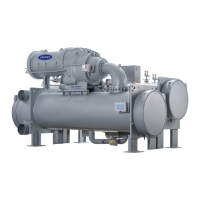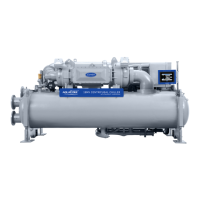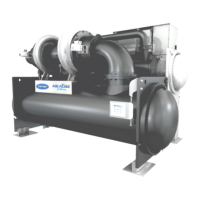18
Refrigerant Tracer — Carrier recommends the use of an
environmentally acceptable refrigerant tracer for leak testing
with an electronic detector.
Ultrasonic leak detectors can also be used if the chiller is
under pressure.
Leak Test Chiller — Due to regulations regarding refrig-
erant emissions and the difficulties associated with separating
contaminants from the refrigerant, Carrier recommends the
following leak test procedure. Refer to Table 5 for refrigerant
pressure/temperature values.
1. If the pressure readings are normal for the chiller
condition:
a. Evacuate the charge from the vessels, if present.
b. Raise the chiller pressure, if necessary, by adding
refrigerant until pressure is at the equivalent satu-
rated pressure for the surrounding temperature.
c. Leak test chiller as outlined in Steps 3 to 9.
2. If the pressure readings are abnormal for the chiller
condition:
a. Prepare to leak test chiller.
b. For cooling machines, check for leaks by connect-
ing a nitrogen bottle with added tracer to allow for
electronic leak detection if possible; otherwise, soap
bubble solution is to be used. Raise the pressure to
20 psig (138 kPa). If electronic leak detector is
available, ensure small amount of tracer material is
added.
c. Plainly mark any leaks that are found.
d. Release the pressure in the system.
e. Repair all leaks.
f. Retest the joints that were repaired (note suggested
test pressure is 20 psig (138 kPa); maximum allow-
able test pressure 45 psig (310 kPa).
3. Check the chiller carefully with an electronic leak detec-
tor or soap bubble solution.
4. Leak Determination — If an electronic leak detector indi-
cates a leak, use a soap bubble solution, if possible, to
confirm. Total all leak rates for the entire chiller. Leakage
at rates greater than 0.1% of the total charge per year
should be repaired. Local regulation governs the require-
ments for when repair of leaks become mandatory. Note
the total chiller leak rate as well as the full charge amount
on the start-up report.
5. If no leak is found during the initial start-up procedures,
complete the transfer of refrigerant gas from the storage
tank to the chiller. Recover any gas used for leak detec-
tion purposes as required per local jurisdiction.
6. If no leak is found after a retest:
a. Perform a standing vacuum test as outlined in the
Standing Vacuum Test section, below.
b. If the chiller fails the standing vacuum test, repeat
leak test and repair.
c. If the chiller passes the standing vacuum test,
dehydrate the chiller. Follow the procedure in the
Chiller Dehydration section, page 20. Charge the
chiller with refrigerant.
7. If the chiller is opened to the atmosphere for an extended
period, evacuate it before repeating the leak test.
NOTE: Alternate optional leak testing method is to isolate
the water circuits and use a portable water heater to raise
the temperature of the cooler and condenser water circuits
to approximately 100°F (38°C) which corresponds to a
pressure of approximately 14.40 psig (99.3 kPag).
Standing Vacuum Test — When performing the
standing vacuum test or chiller dehydration, use a manometer
or a wet bulb indicator. Dial gages cannot indicate the small
amount of acceptable leakage during a short period of time.
1. Attach an absolute pressure manometer or wet bulb indi-
cator to the chiller.
2. Evacuate the vessel to at least 18 in. Hg vac (41 kPa
[abs]), using a vacuum pump or a pumpout unit.
3. Valve off the pump to hold the vacuum and record the
manometer or indicator reading.
a. If the leakage rate is less than 0.05 in. Hg (0.17 kPa
)
in 24 hours, the chiller is sufficiently tight.
b. If the leakage rate exceeds 0.05 in. Hg (0.17 kPa)
in
24 hours, re-pressurize the vessel and test for leaks.
4. Repair the leak, retest, and proceed with dehydration.
WARNING
Do not use air or oxygen as a means of pressurizing the
chiller. Mixtures of HFO R-1233zd(E) and air at elevated
pressure can undergo combustion, resulting in equipment
damage and possible personal injury.
CAUTION
Never charge liquid refrigerant into the chiller if the pres-
sure in the chiller is less than 15 in. Hg (vac) / 380 mm Hg
(vac) for HFO R-1233zd(E). Charge as a gas only, with
the cooler and condenser pumps running, until this pres-
sure is reached, using PUMPDOWN/LOCKOUT (located
in the Maintenance menu) and END LOCKOUT mode on
the PIC5 control interface. Flashing of liquid refrigerant at
low pressures can cause tube freeze-up and considerable
damage.

